Riverside Stamps

Return to Home Page or Altered and Faked stamps Index Page
|
The contents of
this website is copyright protected. Any suggestions for additions or changes are always welcome. |
Fake Used Plate Block Number Singles.
I was recently asked by a fellow EBay seller to look at some used plate number singles that he thought were not quite right. The suspects in question were a Scott #645, #689, #702 and #C12 which he had sent as attached photos in his initial email to me. Upon examination of the suspects I found that all of the plate numbers were all correct for the issues but had been faked. When I presented my findings to the seller he was quite surprised as I was that nyone would fake plate numbers on such common issues. I suspect that used plate number singles are not common and may command a premium. The EBay seller has since given the above four fake used plate number singles along with two other used plate number singles (Scott #620 and #650) with dodgy numbers to me to add to my reference collection of fakes. What follows is my analysis of each individual suspect used plate number singles.
Suspect Scott #645 Used Plate Number Single. (3/29/15)
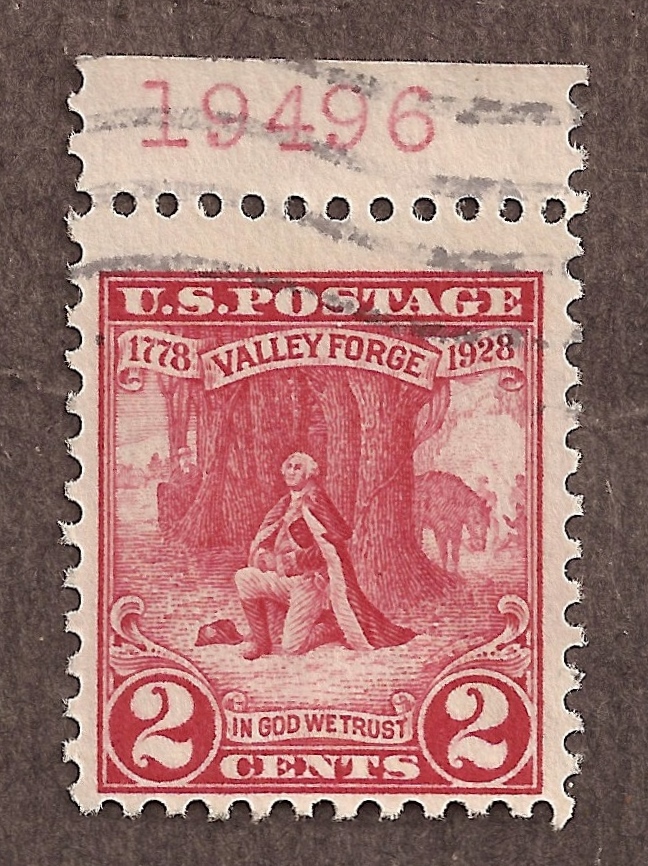
The suspect is a used Scott #645 showing the plate #19496 in the top selvage. Linn’s United States Stamps 1927-32 gives the following plate numbers for this issue: #19493 through #19502. This tells me that the plate number on the suspect is correct for the issue. The thing I noticed about the plate number is the shape of the numbers especially the “9” and the “6” – the extra knobs at the ends of the 9’s and 6 don’t look right. A quick look in the Philatelic Foundations certificate database came back with two plate blocks that were deemed genuine though the numbers were not the same the “1” and “9” of the Philatelic Foundation plate block is enough to show that the suspect is indeed a fake (Fig. 1).

Fig. 1
The fake plate number is on the left and the genuine is on the right and it is obvious from comparing the “19” in each where the fake goes wrong. The base and top serf of the fake “1” are too wide, the top part of the fake “9” is too big, the downward stroke of the fake “9” is slanted whereas the genuine “9”’s downward stroke is more vertical. The end of the fake “9”’s downward stroke ends in a ball while the genuine “9” ends in a small sharp serf. I then went on EBay to find a plate block with the exact number as the suspect (Fig. 2).

Fig 2.
Again the suspect is on the left and the EBay plate number is on the right. The “19” of the EBay plate number matches the “19” of the Philatelic Foundation plate number proving that the EBay plate number is genuine. Looking at the “4” one can see numerous differences between the suspect and the genuine – the vertical stroke of the genuine “4” is separate from the slanted stroke, the horizontal stroke ends in small serfs, the base is small. The suspect’s “4” shows none of these characteristics. The same analysis of the “9” can be applied to the “6” if one assumes the “6” as an inverted “9”.
Conclusion: In my opinion the suspect’s plate number, while correct for the issue, is a fake application.
Suspect Scott #689 Used Plate Number Single. (3/29/15)
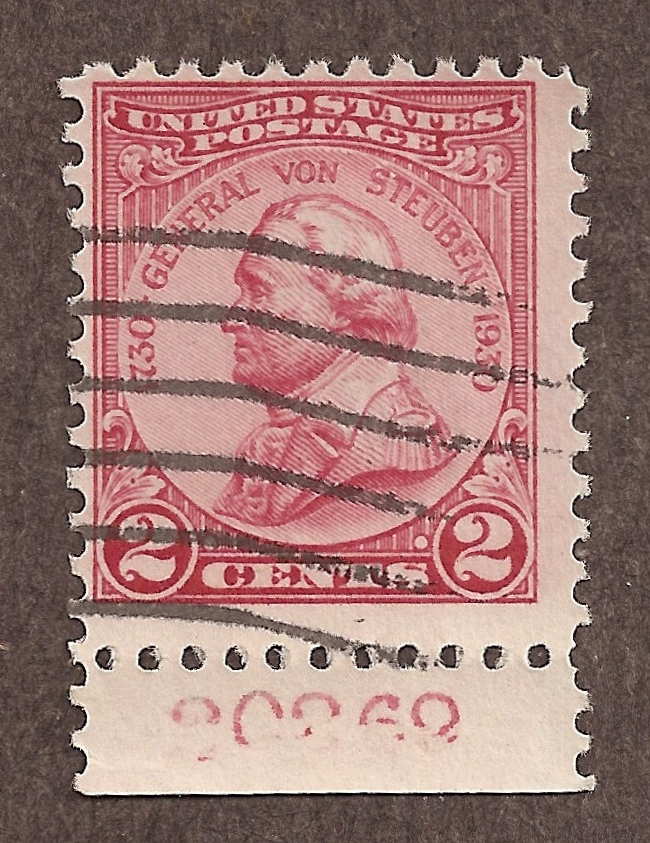
The suspect is a used Scott #689 showing the plate #20268 in the bottom selvage. Linn’s United States Stamps 1927-32 gives the following plate numbers for this issue: #20267 through #20270, #20281 through #20284. This tells me that the plate number on the suspect is correct for the issue. A quick look in the Philatelic Foundations certificate database came back with a plate block that was deemed genuine that had the same plate number as the suspect (Fig. 3).

Fig. 3
There is enough of the suspect’s plate number showing to compare with the genuine plate number on the right. The suspect’s “2”s and “6” each start with a ball while the genuine “2”s and “6” do not. The suspect’s “0” is wide in the middle while the genuine “0” is narrow; the top of the suspect’s “8” is wide whereas the top of the genuine “8” is narrower.
Conclusion: In my opinion the suspect’s plate number, while correct for the issue, is a fake application.
Suspect Scott #702 Used Plate Number Single. (3/29/15)
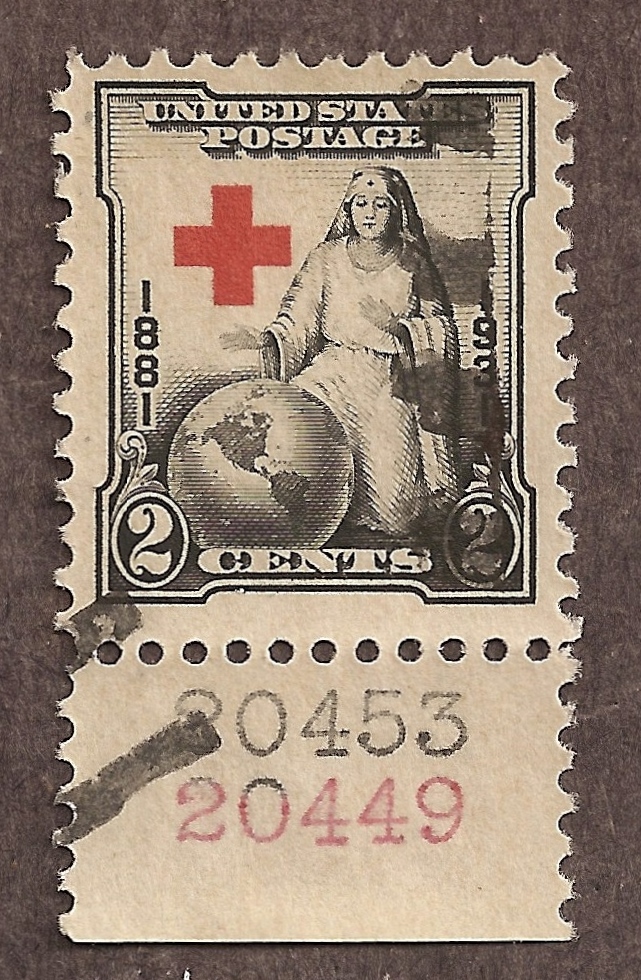
The suspect is a used Scott #702 showing the plate #20453 and #20449 in the bottom selvage. Linn’s United States Stamps 1927-32 gives the following plate numbers for this issue: Frame – total of 24 plates with the lowest being #20434 and the highest being #20525. Cross – 20 plates with the lowest being #20445 and the highest being #20503. This tells me that the plate numbers on the suspect are correct for the issue. A quick look in the Philatelic Foundations certificate database came back with a plate block that was deemed genuine (Fig. 4).

Fig. 4
The first thing to note is that the plate numbers on the genuine are side by side whereas the suspects are one on top of the other. The order of the genuine plate numbers can be black and red as well. The second thing that stands out is that the genuine plate number of the cross is red whereas the suspect’s plate number of the cross is purplish red in color. From there it just comparing the genuine plate number characteristics against the suspects. The bottom of the genuine “2” is flat where the suspect’s is not, the genuine “0” is narrow in the middle but the suspect’s is wide, the genuine “5” ends in a small sharp serf where the suspect’s ends in a ball, the vertical stroke of the genuine “4” is separate from the slanted stroke, the horizontal stroke ends in small serfs, the base is small. The suspect’s “4” shows none of these characteristics, the genuine “3” is all curves beginning and ending in small sharp serfs where the suspect’s “3” has a flat top and begins and ends with a ball. Another thing to note is that the suspect’s “0” is black at the top indicating that a typewriter with a black and red ribbon was used.
Conclusion: In my opinion the suspect’s plate numbers, while correct for the issue, is a fake application.
Suspect Scott #C12 Used Plate Number Single. (3/29/15)
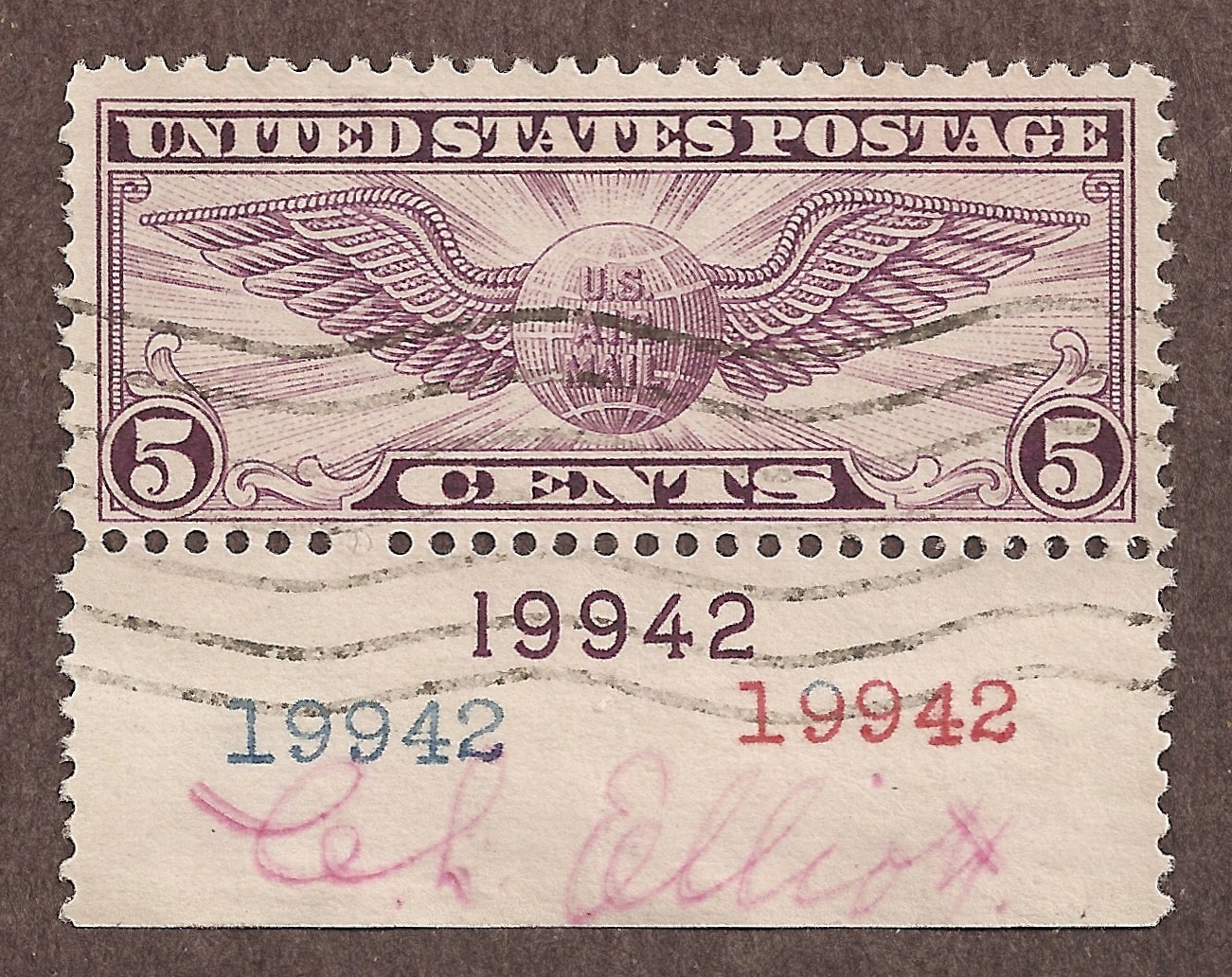
The suspect is a used Scott #702 showing the plate #19942 three times in three different colors in the bottom selvage. Linn’s United States Stamps 1927-32 gives the following plate numbers for this issue: #19941 through 19948, #20187 through #20190 and #. This tells me that the plate numbers on the suspect are correct for the issue. A quick look in the Philatelic Foundations certificate database came back with a plate block that was deemed genuine (Fig. 5).

Fig. 5
Seeing how that Scott #C12 was issued in a single color of violet with a single plate number of the same color the blue and red plate numbers on the suspect make no sense. Comparing the violet plate number of the suspect with the plate number of the genuine example shows that they each share the same characteristics across all numbers therefore in my opinion the violet plate number of the suspect is genuine. That being said the blue and red plate numbers on the suspect are not only the wrong color but share none of the characteristics of the genuine violet plate number.
Conclusion: In my opinion the suspect’s violet plate number is genuine and is correct for the issue, but the blue and red plate numbers, while correct for the issue, are a fake application.
The next two suspects were added to the original four when they were sent to me by the EBay seller.
Suspect Scott #620 Used Plate Number Single. (3/29/15)
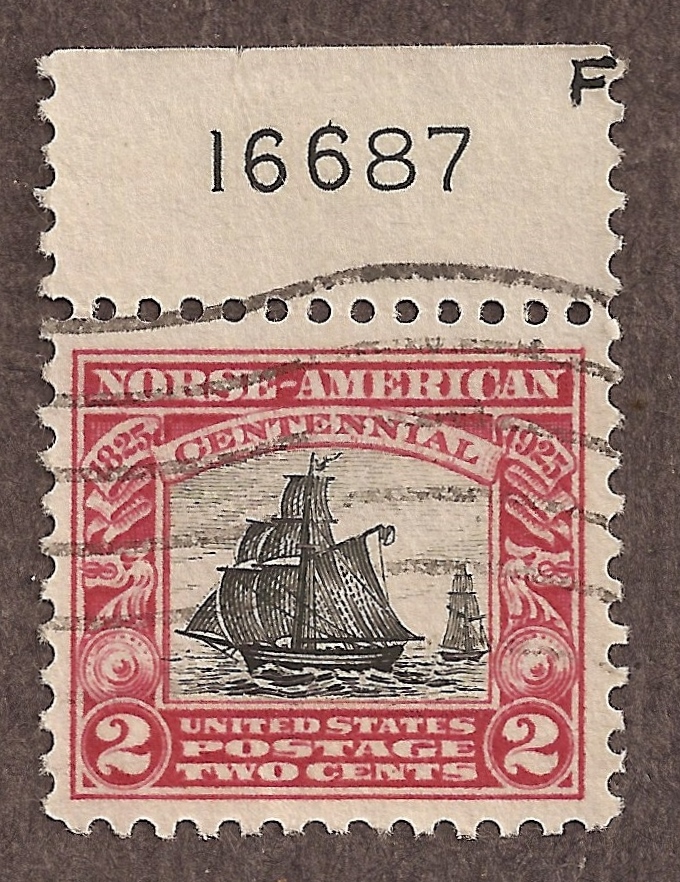
The suspect is a used Scott #620 showing the plate #16687F in the top selvage. Linn’s United States Stamps 1922-26 gives the following vignette plate numbers for this issue: #16687 through 16690, #17353, #17355, #17356 and #17379. This tells me that the plate number on the suspect is correct for the issue. A quick look in the Philatelic Foundations certificate database came back with a plate block that was deemed genuine (Fig. 6).
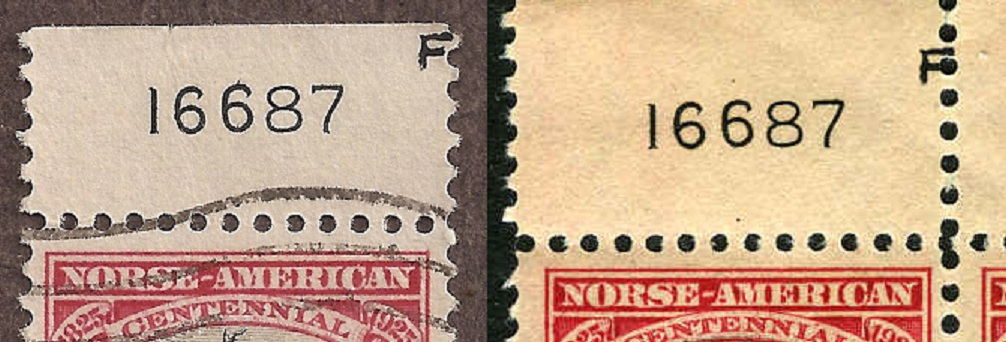
Fig. 6
It’s readily apparent that the suspect’s plate number on the left matches the genuine plate number on the right.
Conclusion: In my opinion the suspect’s plate number is genuine.
Suspect Scott #650 Used Plate Number Single. (3/29/15)
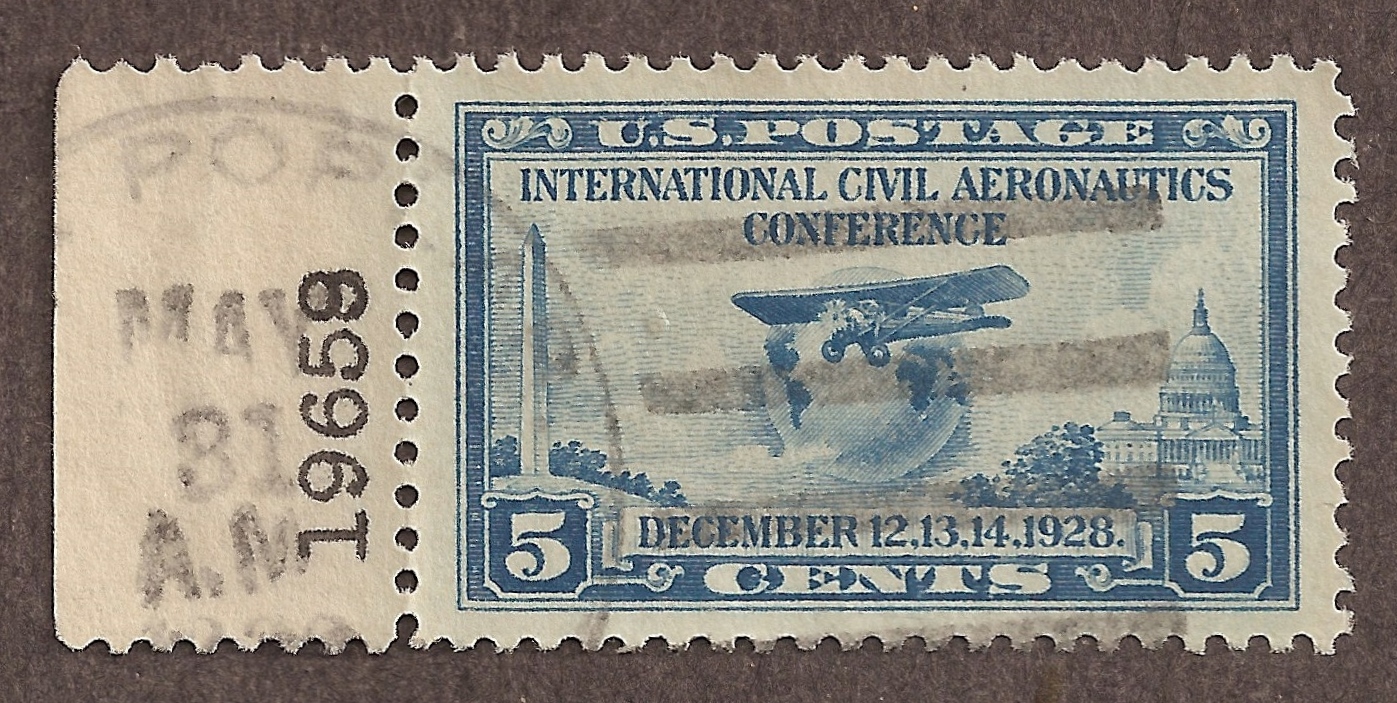
The suspect is a used Scott #650 showing the plate #19658 in the left side selvage. Linn’s United States Stamps 1927-32 gives the following plate numbers for this issue: #19658 through 19661. This tells me that the plate number on the suspect is correct for the issue. A quick look in the Philatelic Foundations certificate database came back with a plate block that was deemed genuine (Fig. 7).

Fig. 7
Scott #650 was issued in the color blue it stands to reason that the plate number would also be in the same color blue but in the case of the suspect the plate number color is black. That being said the black plate number on the suspect is not only the wrong color but share none of the characteristics of the genuine blue plate number.
Conclusion: In my opinion the suspect’s plate number is correct for the issue, but is a fake application.
Reference material used:
- Linn’s United States Stamps 1927-32 by Gary Giffith.
- Linn’s United States Stamps 1922-26 by Gary Giffith.
As always comments and suggestions are always welcome.
To Contact Riverside Stamps:
Email:
Mike Girard - Owner / Operator / Web Master:
g1rardmn1099@comcast.net
|
I am a member of the American Philatelic Society
|
I am a member of the United States Stamp Society  USSS #: 16733 Visit the United States Stamp Society Website at www.usstamps.org |
I am a member of the Perfins Club
|

